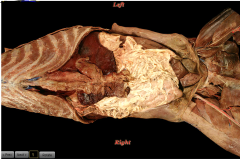![]()
![]()
![]()
Use LEFT and RIGHT arrow keys to navigate between flashcards;
Use UP and DOWN arrow keys to flip the card;
H to show hint;
A reads text to speech;
21 Cards in this Set
- Front
- Back

|
diaphragm |
|
|
the lumbar portion of the diaphragm consists of two tendons referred |
left and right crura |
|

|
left and right crus |
|

|
aortic hiatus |
|

|
caval foramen |
|

|
esophageal hiatus |
|
|
passageway the aorta, azygous vein, and thoraic duct pass through the abdominal cavity |
aortic hiatus |
|
|
passageway the caudal vena cava pass though the abdominal cavity |
caval foramen |
|
|
passageway the esophogus, dorsal and and ventral vagal trunks enter the abdominal cavity |
esophageal hiatus |
|
|
the layer that lines the inner abdominal wall and the caudal (abdominal) surface of the diaphragm |
parietal peritoneum |
|
|
the layer that covers the organs in the abdominal cavity |
visceral peritoneum |
|
|
the blood vessels and nerves to the abdominal organs come from the dorsal part of the abdominal cavity and are carried to the viscera within this layer |
connecting peritoneum |
|

|
falciform ligament |
|
|
the fetal reminant of the fold of peritoneum that supported the umbilical vein |
falciform ligament |
|
|
The band of connective tissue in the free border of the falciform ligametn that is a remnant of the umbilical vein of the fetus |
round ligament of the liver |
|

|
median ligament of the urinary bladder |
|

|
left lateral ligament of the urinary bladder |
|

|
mesoductus deferens |
|

|
greater omentum |
|
|
the greater omentum consists of a _____ and____ leaf with a _______ between them |
Superficial and deep leafs omental bursa |
|

|
lesser omentum |

